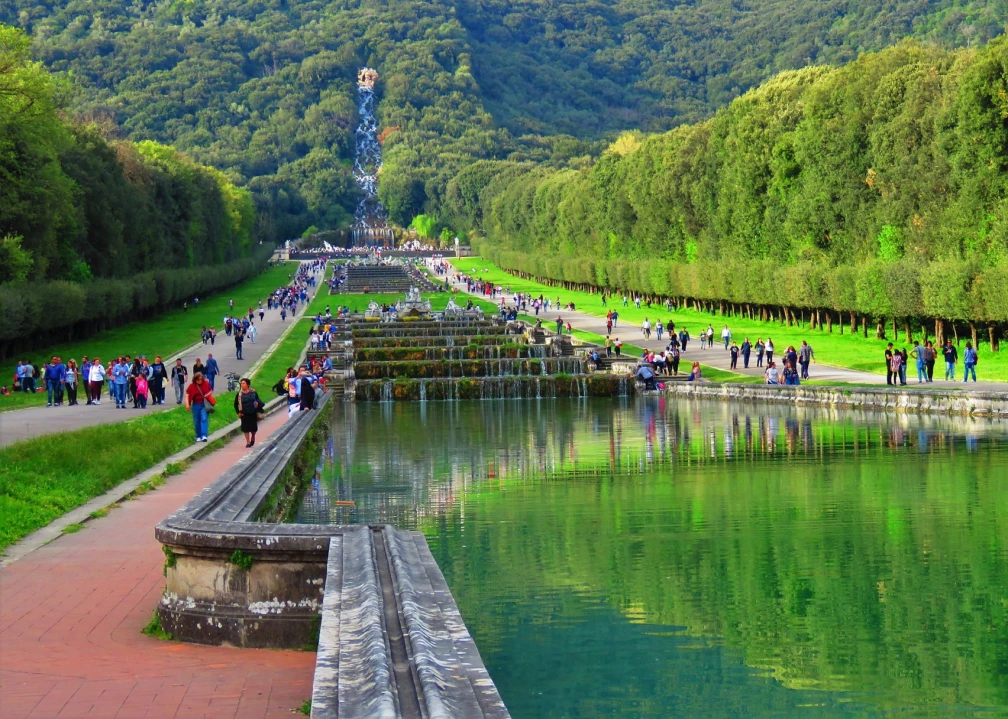Located on the slopes of the Caserta hills, the Reggia di Caserta (Caserta Royal Palace) is a historical residence that belonged to the Royal House of the Bourbons of Naples, declared a World Heritage Site by UNESCO. Built at the behest of Charles III of Bourbon in 1751, under the direction and design of architect Luigi Vanvitelli, it is surrounded by a vast park, which extends for 3 kilometres of length, with south-north development, on 120 hectares of surface area. The park is divided into two sectors: the Italian Garden and the English Garden.
The Italian Garden and the English Garden
At the center of the rear façade of the palace, the central main boulevard starts with a series of fountains, pools, waterfalls and the famous Great Waterfall which, starting from the northern edge of the Italian Garden, connects to the English Garden. The latter was built in 1785 by Sir John Andrew Graefer at the behest of Queen Maria Carolina of Austria, impressed by the trend of the moment in vogue in Europe of the English style gardens designed by William Kent.
The English Garden occupies an area of about 23 hectares on which Graefer planned the arrival of different species of plants from England, America and The Netherlands for his botanical studies, and in a short time gave life to hills, clearings, lakes and canals fed by the waters of the Carolino Aqueduct. Following the landscape fashion, many fabriques were built to help stop and relax the royal family, amid fake ruins and winding paths. Attention to botany influenced part of the activities carried out inside the garden: there was in fact a fruit-bearing plant, an asparagus, a phrasing plant with works aimed at the cultivation and multiplication of bulbs, ornamental plants and leguminous plants. Vaseries and stoves were organized to help these functions.
The Bourbon Greenhouse and the Bath of Venus
In a secluded recess of the English Garden there is an iron and glass greenhouse for the cultivation of plants: called Bourbon Greenhouse (Serra Borbonica), it is an interesting example of a building designed to protect plants and an important testimony of the structures that began to appear in the early nineteenth century in the main Italian gardens. The neoclassical façade is punctuated by a series of imposing Doric columns. The roof has been replaced with an iron and glass roof that enhances the interior brightness.
Another suggestive environment rich of picturesque views is the Bath of Venus (Bagno di Venere), so called for the presence of a marble statue of Carrara that portrays the goddess in the act of coming out from the water of a small lake, surrounded by a forest of laurels, holm oaks and an exceptional 100 year old specimen of Taxus baccata.
The plants in the English Garden
The English Garden became a veritable botanical garden where were visible significant examples of Cinnamomum camphora, Cedrus libani and what is supposed to be the first camellia plant (Camellia japonica) arrived in Europe and destined for the garden at the will of Maria Carolina. It is divided into different areas, dedicated to 14 vegetable collections such as palm trees, cacti, holly trees, holly trees in the ground, aquatic plants, oaks, eucalyptus, maples, walnuts, boxwoods, conifers, fruit trees, camellias and ferns.




